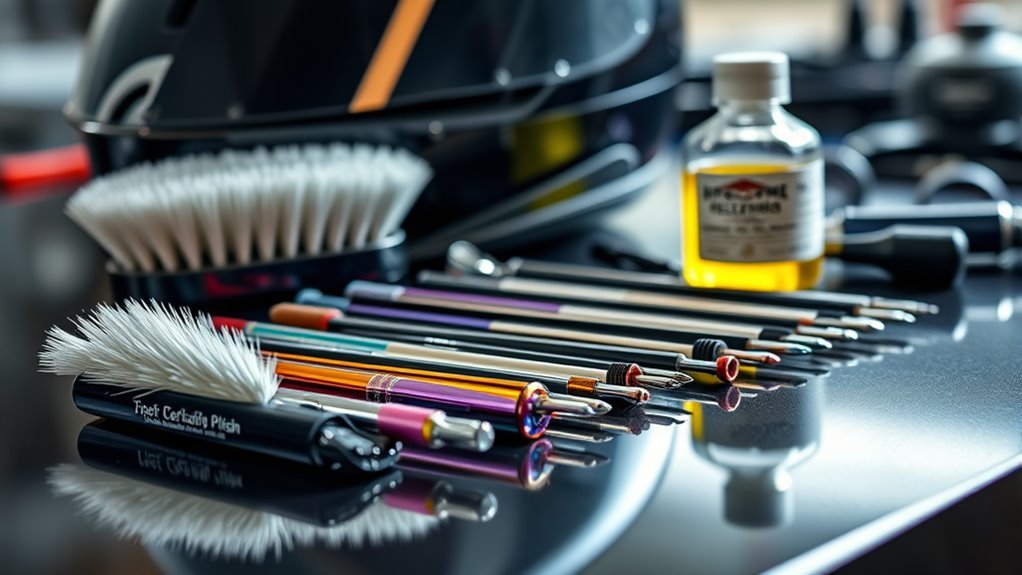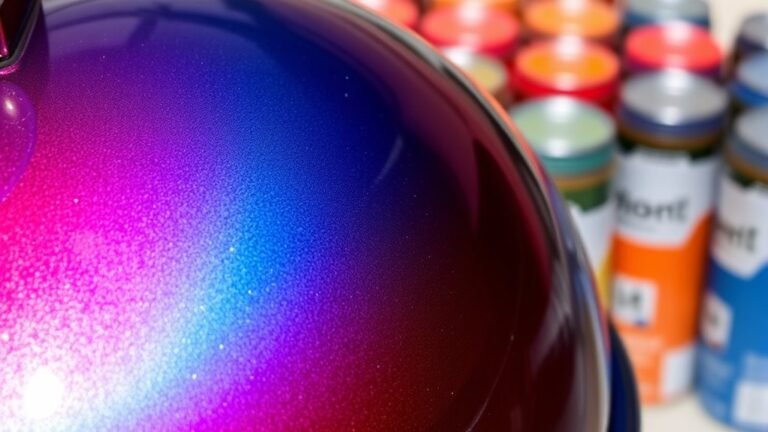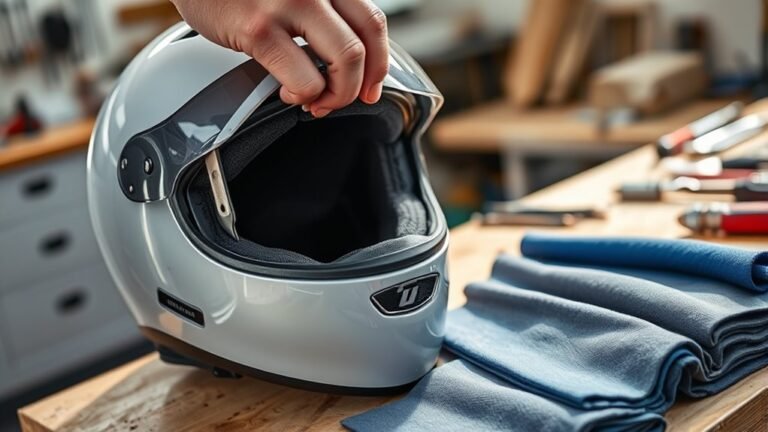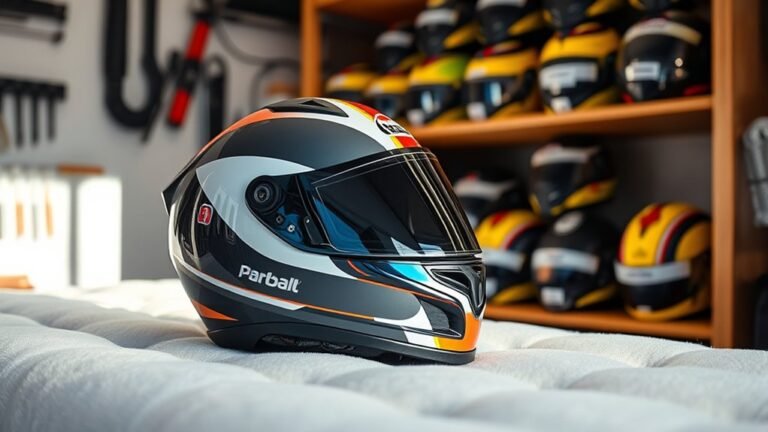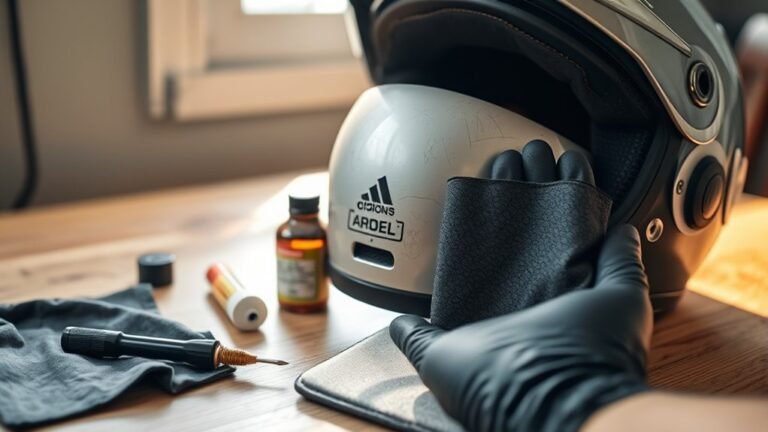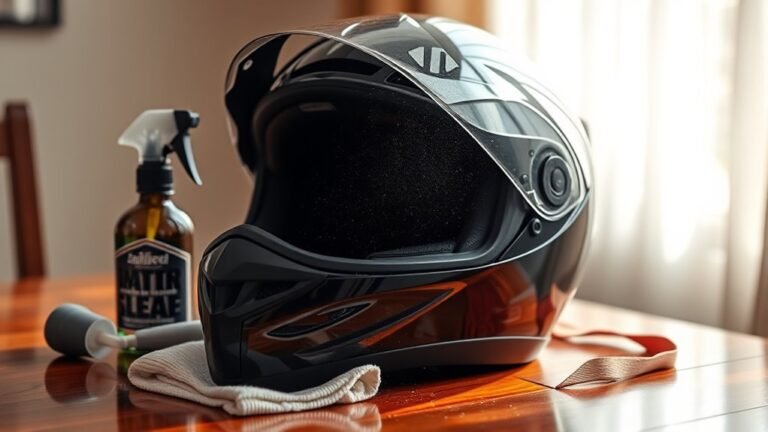Best Tools for Helmet Detailing
For effective helmet detailing, invest in quality tools. Use microfiber cloths for a streak-free finish and soft-bristle brushes for gentle cleaning. Helmet detailing kits often include specialized cleaners and microfiber cloths tailored for safe application. Don’t forget visor cleaning tools; they prevent scratches while keeping visibility clear. Consider protective coatings to extend your helmet’s lifespan. For ideal maintenance, you’ll discover additional tips that can enhance your detailing routine further.
Essential Cleaning Solutions
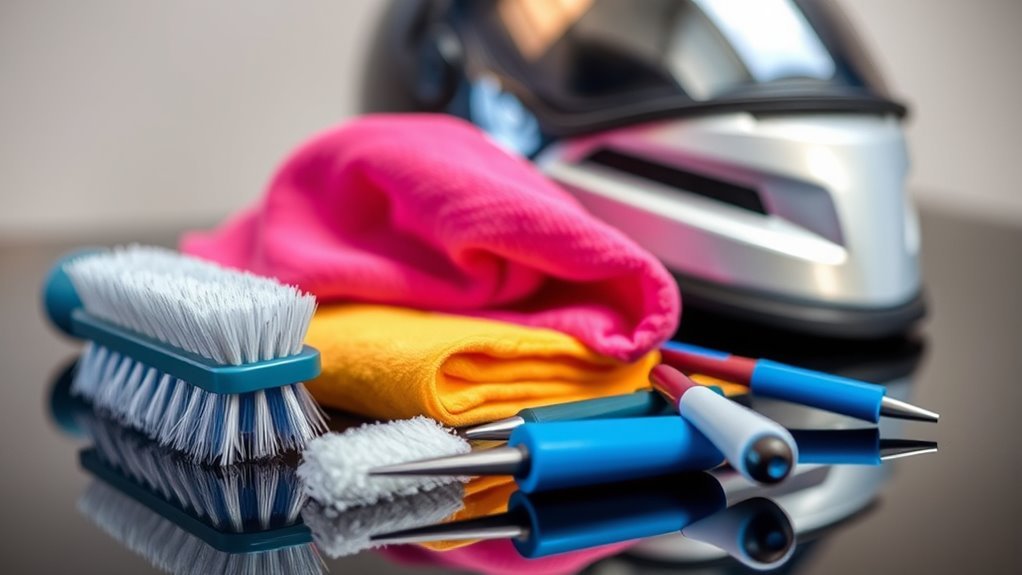
When it comes to helmet detailing, having the right cleaning solutions is vital for maintaining both hygiene and appearance. You should consider incorporating natural cleaning alternatives into your helmet maintenance routines. These solutions, like vinegar or baking soda, effectively break down grime without harsh chemicals that could damage your helmet’s materials. For routine cleaning, a simple mixture of warm water and mild soap can work wonders in removing dirt and sweat. Regularly cleaning the interior padding is important to prevent odors and bacteria buildup. By using these natural alternatives, you not only protect your helmet but also contribute to a healthier environment. Adopting these practices guarantees your gear stays in top condition, allowing you the freedom to ride confidently.
Microfiber Cloths and Towels

Microfiber cloths and towels are essential tools for effective helmet detailing, boasting superior cleaning capabilities compared to traditional materials. Available in various microfiber types, these cloths are designed to lift and trap dirt, dust, and grime without scratching delicate surfaces. When choosing a microfiber towel, consider the cloth durability; higher GSM (grams per square meter) indicates a denser, more durable towel that can withstand multiple washes. Opt for a blend of polyester and polyamide for peak performance and longevity. With their ability to absorb moisture at an impressive rate, microfiber towels guarantee a streak-free finish, making them indispensable in your detailing kit. For a helmet that reflects your freedom and style, invest in quality microfiber products for the best results.
Soft-Bristle Brushes
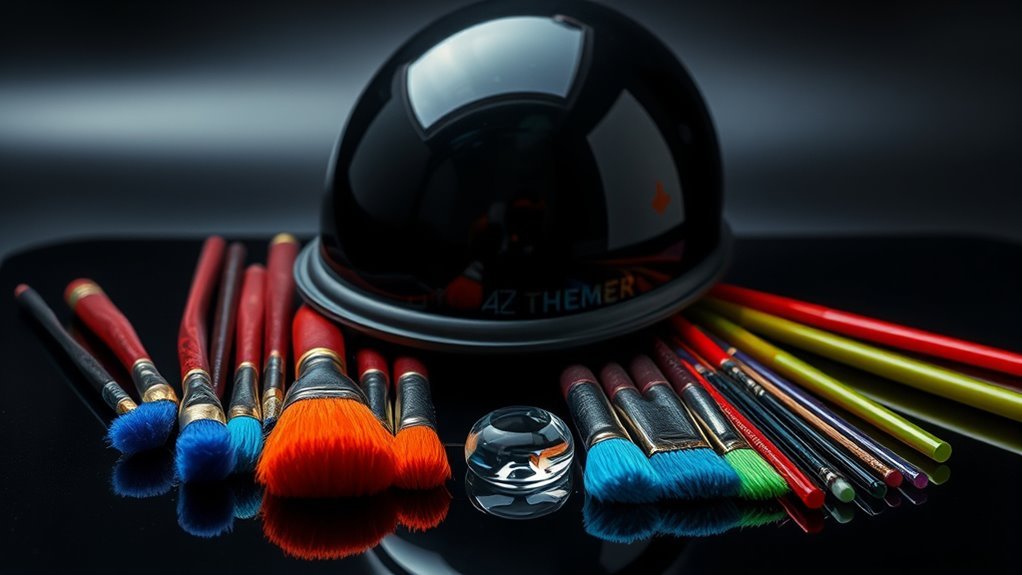
Soft-bristle brushes are invaluable tools for achieving a thorough clean on helmets without risking damage to their surfaces. These brushes come in various bristle types, allowing you to select the right one for specific materials and coatings. When using soft-bristle brushes, employ effective brush techniques, such as gentle circular motions, to dislodge dirt and grime without scratching. Focus on areas where debris accumulates, like vents and seams, guaranteeing you don’t miss those hard-to-reach spots. Remember, the softness of the bristles guarantees that you maintain the helmet’s integrity while providing a deep clean. Investing in a good-quality soft-bristle brush can enhance your detailing process and prolong the life of your helmet, giving you the freedom to ride with confidence.
Helmet Detailing Kits
For those looking to streamline their helmet cleaning process, helmet detailing kits offer a thorough solution. These kits typically include essential detailing products designed for effective helmet care. With the right kit, you can maintain your helmet’s appearance and prolong its lifespan.
Here are three key components you’ll often find in these kits:
- Specialized Cleaners: Formulated to remove dirt, grime, and grease without damaging the helmet’s finish.
- Microfiber Cloths: These help in applying cleaners without scratching surfaces, guaranteeing a safe clean.
- Protective Sprays: Often included to provide a layer of protection against UV rays and environmental elements.
Using a helmet detailing kit not only simplifies your maintenance routine but also guarantees your helmet stays in peak condition.
Visor Cleaning Tools
When it comes to cleaning your helmet visor, using microfiber cloths is essential for preventing scratches and preserving clarity. Specialized visor cleaners are designed to remove grime without damaging coatings, ensuring maximum visibility. Selecting the right tools can enhance your cleaning routine and extend the lifespan of your visor.
Microfiber Cloth Benefits
Although many tools can assist in helmet detailing, microfiber cloths stand out as essential for visor cleaning due to their unique properties. Here are some microfiber advantages that enhance your cleaning efficiency:
- Softness: Microfiber is gentle on surfaces, reducing the risk of scratches on your visor.
- Absorbency: These cloths can trap dirt and moisture effectively, guaranteeing a streak-free finish.
- Durability: Microfiber cloths withstand multiple washes without losing their cleaning power.
Using microfiber for visor cleaning not only guarantees that your helmet looks great but also preserves its integrity over time. By incorporating microfiber cloths into your helmet detailing routine, you can enjoy a clearer view and safer rides, embodying the freedom that comes with proper maintenance.
Specialized Visor Cleaners
While many riders rely on microfiber cloths for basic visor maintenance, specialized visor cleaners offer targeted solutions that enhance both cleaning efficiency and visor protection. These products often incorporate advanced cleaning techniques designed to remove stubborn grime without damaging the visor’s surface. When you prioritize visor care with these cleaners, you’re not just improving visibility; you’re also extending the life of your helmet.
| Cleaner Type | Key Features | Best Use |
|---|---|---|
| Foam Cleaner | Non-abrasive, easy to apply | General cleaning |
| Spray Cleaner | Fast-drying, streak-free finish | Quick touch-ups |
| Wipes | Convenient, portable | On-the-go cleaning |
| Anti-fog Spray | Prevents fogging | Cold weather rides |
| UV Protectant | Shields against sun damage | Long-term care |
Invest in specialized visor cleaners for superior results.
Protective Coatings
To guarantee your helmet remains in peak condition, applying a high-quality protective coating is essential. These coatings not only enhance the helmet’s appearance but also provide a barrier against environmental damage. Here are three effective options:
- Ceramic Coatings: These offer long-lasting durability and resistance to scratches, UV rays, and chemicals, making them ideal for outdoor use.
- Protective Sprays: Easy to apply, these sprays create a protective layer that repels dirt and moisture, ensuring your helmet stays clean.
- Wax-Based Coatings: While less durable than ceramic options, wax provides a glossy finish and decent protection, ideal for occasional riders.
Choose the right coating for your needs, and keep your helmet looking fresh while enjoying the freedom of the ride!
Storage and Maintenance Accessories
Proper storage and maintenance accessories are essential for extending the life of your helmet. Utilizing the right tools can considerably enhance your helmet’s durability and performance. Here’s a quick overview of key accessories:
| Accessory Type | Purpose |
|---|---|
| Helmet Bag | Protects from dust and damage |
| Helmet Stand | Prevents deformation |
| Cleaning Kit | Maintains cleanliness |
| UV Protection Spray | Shields against sun damage |
Incorporating these items into your helmet storage routine can make a difference. Regular maintenance routines, such as cleaning and inspecting your helmet, guarantee it remains in peak condition. By investing in quality accessories, you’ll enjoy the freedom of riding with a well-maintained helmet for years to come.
Additional Tips for Effective Detailing
Effective detailing goes beyond just cleaning; it involves a systematic approach to guarantee your helmet remains in prime condition. To achieve this, consider the following tips:
- Adopt Proper Detailing Techniques: Use soft brushes and microfiber cloths to prevent scratches while effectively removing dirt and grime.
- Establish a Cleaning Frequency: Regularly clean your helmet—ideally after every ride or weekly—to maintain its integrity and appearance.
- Inspect for Damage: During each detailing session, check for any cracks or wear that could compromise safety.
Frequently Asked Questions
How Often Should I Detail My Helmet?
You should detail your helmet at least once a month, especially if you use it frequently. Regular maintenance keeps it looking sharp and guarantees safety. Use helmet maintenance tips like inspecting for scratches and cleaning the interior. If you ride in harsh conditions, consider detailing more often—every two weeks might be necessary. Following this detailing frequency advice not only enhances your helmet’s lifespan but also boosts your riding confidence. Stay safe and stylish!
Can I Use Regular Soap for Cleaning?
Sure, you can use regular soap, but let’s not pretend it’s the best choice. Regular soap might strip away essential oils, leaving your helmet feeling as neglected as a forgotten pet rock. Instead, consider soap alternatives like mild dish soap or specialized helmet cleaners. These cleaning techniques maintain your helmet’s integrity while ensuring it looks sharp. Remember, freedom isn’t just riding; it’s also about keeping your gear in top condition!
What’s the Best Way to Remove Stubborn Stains?
To effectively remove stubborn stains, you should use targeted stain removal techniques. Start by applying a small amount of a specialized cleaner or a mixture of water and mild detergent directly to the stain. Let it sit for a few minutes, then gently scrub with a soft cloth or sponge. Rinse thoroughly with water to avoid residue. Repeat if necessary, but always test in an inconspicuous area first to guarantee it doesn’t damage the surface.
Are There Specific Products for Different Helmet Materials?
Imagine your helmet as a delicate flower, needing the right environment to thrive. Yes, there’re specific products for different helmet materials. For instance, polycarbonate helmets flourish with mild cleaners, while fiberglass may need specialized solutions. Always check for material compatibility to avoid damage. Proper helmet care guarantees longevity, allowing you the freedom to ride safely. Tailor your cleaning arsenal to match your helmet’s unique needs, keeping it pristine and ready for adventure.
How Do I Prevent Scratches on My Helmet?
To prevent scratches on your helmet, follow these helmet maintenance tips: always store it in a dedicated bag or case, avoiding direct contact with rough surfaces. Use microfiber cloths for cleaning; they’re gentle and won’t leave marks. Apply a protective coating designed for your helmet’s material, enhancing scratch resistance. Additionally, avoid placing your helmet upside down, as debris can accumulate on the interior, leading to potential scratches when you put it on.
